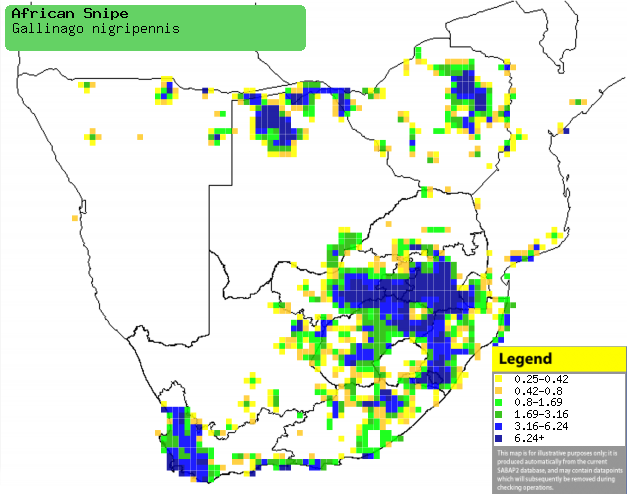|
Gallinago nigripennis (African
snipe, Ethiopian snipe)
Afrikaanse snip [Afrikaans]; Umnquduluthi [Xhosa];
uNununde [Zulu]; Nkoko [Kwangali]; Koe-koe-lemao (generic term for sandpiper),
Motjoli-matsana [South Sotho]; Afrikaanse snip [Dutch]; Bécassine africaine
[French]; Afrikanische bekassine [German]; Narceja-africana [Portuguese]
Life
> Eukaryotes >
Opisthokonta
> Metazoa (animals) >
Bilateria >
Deuterostomia > Chordata >
Craniata > Vertebrata (vertebrates) > Gnathostomata (jawed
vertebrates) > Teleostomi (teleost fish) > Osteichthyes (bony fish) > Class:
Sarcopterygii (lobe-finned
fish) > Stegocephalia (terrestrial
vertebrates) > Tetrapoda
(four-legged vertebrates) > Reptiliomorpha > Amniota >
Reptilia (reptiles) >
Romeriida > Diapsida > Archosauromorpha > Archosauria >
Dinosauria
(dinosaurs) > Saurischia > Theropoda (bipedal predatory dinosaurs) >
Coelurosauria > Maniraptora > Aves
(birds) >
Order: Charadriiformes > Family: Scolopacidae
Distribution and habitat
Occurs in patches of sub-Saharan Africa, from Ethiopia
through Uganda and eastern DRC to Zambia, Angola and southern Africa. Here it is
uncommon to locally common in north-eastern Namibia (including the Caprivi
Strip), northern and south-eastern Botswana, central Zimbabwe, small patches of
Mozambique and much of South Africa, largely excluding the Northern Cape and
Limpopo Province. It generally prefers freshwater and brackish wetlands, such as
vleis, marshes, wet grasslands at high altitudes, margins of well-vegetated pans
and riparian wetlands around artificial water bodies.
|
 |
|
Distribution of African snipe in southern Africa,
based on statistical smoothing of the records from first SA Bird Atlas
Project (©
Animal Demography unit, University of
Cape Town; smoothing by Birgit Erni and Francesca Little). Colours range
from dark blue (most common) through to yellow (least common).
See here for the latest distribution
from the SABAP2. |
Predators and parasites
Movements and migrations
It can be sedentary, locally migratory or
nomadic depending on environmental conditions, as for example it is
largely absent from Zimbabwe in the period from January-April, when
it probably disperses to other adjacent countries. It may also move
out of an area if wetlands dry up or otherwise change for the worse.
Food
Its diet mainly consists of annelids, insect larvae, small
molluscs, crustaceans and seeds, doing most of its foraging by probing soft mud
with its long bill.
Breeding
- Monogamous, solitary nester, performing a strange courtship display in
which it dives to the ground from a high vantage point, beating its wings
against its tail feathers in such a way that it produces a drumming sound.
- The nest is probably built solely by the female, consisting of a
saucer-shaped grass structure placed in a tuft of grass or rushes.
- Egg-laying season is almost year-round, peaking from March-August in
Zimbabwe and July-September in the Limpopo Province and Western Cape.
- It lays 1-3, usually 2 eggs, which are incubated solely by the female,
who is well concealed by the vegetation adjacent to the nest.
- The chicks are brooded by both parents, probably leaving the nest at
roughly 19-20 days old and becoming fully independent soon afterwards.
Threats
Not threatened, although previously hunted quite
intensively up to the 1940s, the practice decreased in popularity thereafter.
However game-bird hunting is now gaining renewed interest, which could be cause
for concern.
References
-
Hockey PAR, Dean WRJ and Ryan PG 2005. Roberts
- Birds of southern Africa, VIIth ed. The Trustees of the John Voelcker
Bird Book Fund, Cape Town.
|
